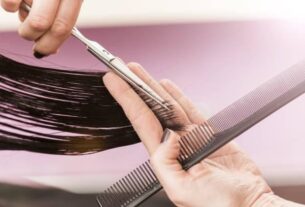Crisp mornings, warm afternoons, and the slow return of cozy layers make fall easy to love. Your hair, though, may feel differently. The shift from summer humidity to drier, cooler air is a classic frizz trigger. Add in the static from scarves, beanies, and high collars, and strands quickly lose their smoothness.
That’s why autumn calls for a fresh approach: more moisture, gentler repair, and styling habits that keep hair glossy instead of flyaway. Building the right routine will help keep your hair looking polished all season.
Why Hair Frizzes More in Fall
Frizz starts when the cuticle, the hair’s outer shield, won’t lie flat. Once it lifts, moisture slips in and out too quickly, and strands puff, shrink, or lose their smoothness.
In summer, humidity is the main culprit, swelling the hair until it frays. In autumn, the problem flips. The air outside turns cooler and drier, while indoor heating robs even more moisture from the fiber. Add in gusty winds, friction from scarves and sweaters, and the temptation of hotter showers, and you’ve got the perfect recipe for static and raised cuticles.
The solution isn’t to weigh hair down with extra product. What works is keeping hydration and strength in balance, smoothing and sealing the cuticle, and paying attention to how your hair interacts with its environment, from the way you wash it to what fabric you’re sleeping on.
Wash Smarter, Not More Often
If summer had you washing often to clear sweat and sunscreen, fall is the time to pull back. Frequent washing in drier weather strips away the natural lipids that help the cuticle stay smooth, leaving hair more prone to static and breakage.
Start by spacing washes an extra day and swapping in a cleanser that protects the scalp’s barrier. Look for surfactants derived from amino acids or sugars and a pH close to that of hair and scalp. Aim shampoo at the roots, then let the suds glide through the lengths as you rinse, so the ends don’t get over-dried.
On wash days, finish with a cool rinse. Cooler water helps the cuticle lie flatter than a steaming rinse ever could. If you live with hard water, add a gentle chelating step once every week or two. This lifts mineral buildup that roughens the hair’s surface and amplifies frizz. Just make sure to follow with a conditioner that restores slip and softness without weighing hair down.
Condition Smarter, Not Heavier
Conditioner isn’t optional in autumn. Cooler, drier air pulls moisture from the hair, so skipping this step leaves strands rough and harder to manage.
Apply conditioner from the ears down, then work it through with your fingers or a wide-tooth comb to distribute evenly and detangle. Contact time matters too, so give it at least three minutes to smooth and lubricate the cuticle.
Fine hair thrives on lightweight formulas with ingredients like betaine, panthenol, or low-molecular-weight proteins that strengthen without collapsing volume. Coarse or curly hair benefits from richer blends with butters and oils that mimic the scalp’s own protective lipids.
And here’s a stylist trick: emulsify conditioner with a splash of water in your palms before applying. The extra slip helps spread it evenly, prevents heavy spots, and makes the product work harder using less.
Mask Like You Mean It
A weekly mask is one of the fastest ways to see a difference when the air turns cooler. Just one treatment can smooth rough texture, reduce frizz, and bring back shine.
Hydration masks focus on humectants and film formers. They pull water in, then lock it there, keeping strands supple and less prone to static.
Strength masks rely on proteins and amino acids. These temporarily patch tiny gaps in the cuticle, which makes hair feel stronger, smoother, and easier to style.
For most hair types in autumn, alternating between the two works best. If your hair is low-porosity or easily overloaded, shorten mask time to five to eight minutes and rinse thoroughly. A lightweight leave-in afterward can seal everything in without heaviness.
The Layering Trick for Frizz-Free Days
What you do after rinsing makes all the difference. Think of leave-ins like skincare serums for your hair: one layer hydrates, the next smooths, the last seals.
Step 1: Hydrate — Start with a lightweight spray. Look for protein-peptide blends or panthenol to add slip and quench thirsty strands.
Step 2: Smooth — Work a cream or milk through the mid-lengths, especially around the crown, where flyaways tend to show first.
Step 3: Seal — Finish with a small amount of serum or oil blend on the ends. This locks everything in and helps hair stay glossy through the day instead of attracting static.
The key is thin, even layers rather than one heavy product. Layering keeps hair touchable and frizz-resistant without that coated feel.
The Hidden Frizz Factor: Fabric
Your favorite fall layers can undo your smooth styling. Wool scarves, chunky knits, and high collars create friction that ruffles the outer layer of your hair. Instead of giving them up, line hats with silk or satin, or look for beanies that already have soft interiors. If you wear your hair down against coats, smooth a micro-drop of serum onto the underside that rubs against fabric. Paying attention to these small details keeps your look polished without sacrificing your favorite sweater and scarf combo.
Ingredients That Actually Tame Frizz
Not all formulas are created equal. The right ingredients smooth the cuticle and protect strands, while the wrong ones leave hair drier and harder to manage.
What to look for:
- Cationic conditioners that cling to hair and make it feel soft and conditioned.
- Amide-based film formers that create a light, breathable shield.
- Low-molecular-weight proteins that slip into tiny gaps in the cuticle for smoother, stronger hair.
- Lightweight silicones (or silicone alternatives like polyquats and plant esters) that seal, reduce friction, and add gloss without heavy buildup.
What to avoid:
- Overusing harsh clarifiers which strip too much and leave hair vulnerable.
- Styling products that rely on high levels of drying alcohols if your hair already feels brittle.
- Volumizing sprays without a hydrating base can make hair feel crackly instead of full.
Choosing smarter formulas means every step works toward a smoother, shinier finish.
Strong Hair Starts at the Scalp
A healthy scalp lays the groundwork for smoother, stronger hair. In autumn, dry air and hotter showers can leave the scalp tight or flaky, which often shows up as dullness through the lengths.
The fix is gentle, consistent care. Once a week, add a lightweight scalp serum with humectants to draw in moisture and lipids to support the skin barrier. Massage with fingertips or a soft silicone tool to boost circulation without scratching.
Keep water lukewarm on wash days. Scalding heat strips the scalp and stresses both roots and strands. And if you’re stretching the time between shampoos, try a targeted micellar or amino acid-based cleanser. It refreshes roots without drying the rest of your hair, keeping everything balanced until your next full wash.
Targeted Treatments That Work
Autumn is the season to undo summer stress before frizz sets in for good. UV exposure, chlorine, and salt water can leave the cuticle rough, which means styling feels harder and frizz shows faster. Treatments that rebuild the surface make hair look smoother and behave better.
Bond-support formulas and cuticle-smoothing treatments are especially effective this time of year. A salon gloss can instantly polish the outer layer, while at-home options extend that finish between appointments. If you want a treatment that respects movement without weighing hair down, reach for products designed to restore cuticle alignment and balance moisture.
This is where Mayraki Silky Smooth Proactive Hair Repairing Treatment comes in. Used as an occasional booster, it calms roughness left by summer, strengthens the fiber, and helps hair stay polished without losing its natural body.
What Keratin Really Does for Your Hair
Keratin gets a mixed reputation. Some people picture stiff, salon-only treatments that flatten texture. In reality, keratin is simply a structural protein your hair already has, and in the right dose, it can make strands smoother and stronger without taking away movement.
The trick is choosing the right format. For most hair types, small amounts of hydrolyzed keratin or amino-acid blends give just enough reinforcement to calm frizz. Medium- to high-porosity hair often benefits most, since the cuticle is already lifted and needs help staying sealed. For fine or low-porosity hair, stick with micro-doses that won’t tip the balance.
This season, the Mayraki Organic Hydrolyzed Keratin Instant Smoother System offers an autumn-friendly way to test keratin’s benefits. It strengthens and smooths stressed hair while keeping the finish soft and natural.
Protecting Color Through Fall
Color-treated hair tends to frizz faster because dye lifts the cuticle. Protecting it means switching to cleansers and conditioners that are color-safe and slightly acidic, which helps keep pigment locked in and the surface smoother. Glosses between highlight sessions can also refill porosity and keep shine intact.
Heat styling makes the problem worse, so think medium heat, steady tension, and patience instead of maxing out your tools. Always pair color care with a thermal protectant, and your strands will stay brighter and more manageable through the season.
Gym, Weather, and Real Life
Autumn schedules tend to get busier, which means you need flexible routines. Frizz doesn’t wait for the right moment, so it helps to have a few strategies ready for whatever the day throws at you.
At the gym: Braid hair or tie it back with a satin scrunchie to cut down on friction and sweat. Keep a hydrating mist and a small brush in your bag for an easy post-workout reset.
On rainy days: Don’t fight your natural pattern. Set curls or waves with a light gel cast before stepping out, then let them dry under a hood or umbrella for a smoother finish.
In everyday rushes: Focus on prevention, not rescue. A few simple steps before you leave the house, like sealing ends with serum, make touch-ups later much easier.




